Niche sites generate 53% higher engagement rates compared to general-topic websites. Specializing in the right niche means that your content and marketing efforts target a smaller, more specific audience segment—one that shows a genuine interest or need for the particular products, services, or topics you cover.
That's why in this post, I'll walk you through how to find your niche in nine steps. I'll also show some niche market examples and highlight lucrative businesses that managed to find success in otherwise hyper-specialized market segments.
What you will learn
- Steps to identify and evaluate potential niches.
- How to assess competition, market size, and growth trends.
- How to evaluate financial sustainability and avoid common mistakes.
- Real-life examples of successful niche businesses and websites.
What is a niche?
A niche is a specialized market segment that focuses on a particular product or service type. Unlike an entire industry or a broader market, a niche targets a specific audience segment within that area.
For example, supplements for gym-goers and anti-aging supplements would be considered as two separate niches in the dietary supplements industry.
Niches can also apply to other website types, like blogs. The Minimalists is a blog that specifically targets readers looking to simplify their lives.

This specialized approach allows for more targeted marketing efforts and generally lower competition levels. As such, finding your niche helps attract more potential customers, improve conversion rates, and build customer loyalty.
Why is finding your niche important?
Finding your niche allows you to concentrate your product/service offering, unique selling point, and overall marketing strategy to a high-interest consumer segment.
This helps establish your company as the go-to resource for customer bases within that segment, which contributes to building brand authority and customer loyalty.
Finding your niche also helps minimize competition. Broader markets are usually taken up by huge industry authorities, so specialized areas within those markets help you bypass them.
Better SEO rankings and marketing ROI come as side effects here.
For example, Nerd Fitness targets fitness enthusiasts who identify as nerds or geeks. The website oozes with pop culture references all throughout its content.
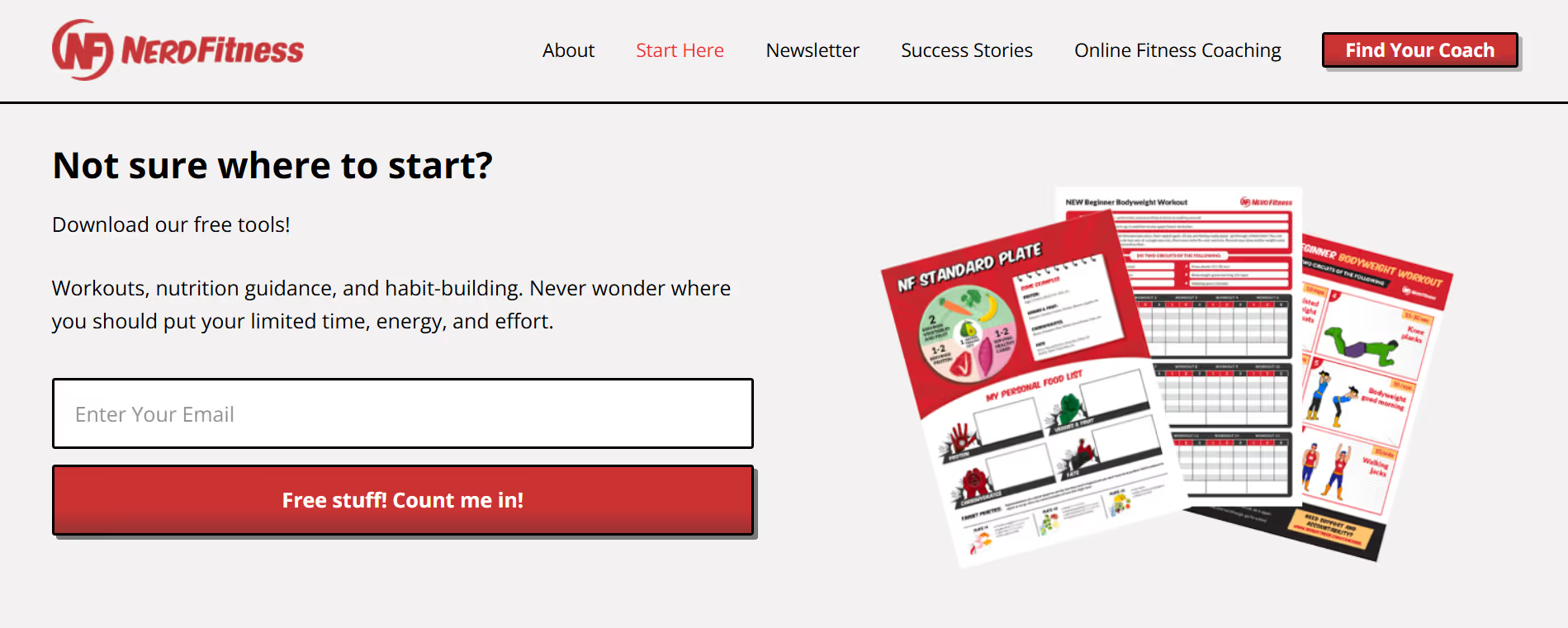
It's safe to say not every fitness enthusiast is also into pop culture. NerdFitness built its entire business on that idea, managed to attract a steady flow of recurring visitors, and stood out in an otherwise oversaturated market.
9 steps to find your niche
Having covered the what and why, let's see how to find your niche in nine steps. I'll also walk you through real-life examples along the way to better guide your approach.
1. Pick within your circle of expertise
Choose a niche where you already have some knowledge, skills, or first-hand experience. Focus on areas where you can comfortably present the ins and outs of their topics with confidence and authority.
This gives you a head start. Studying a completely new niche well enough to reach a level where you can teach others about it would take a while.
Plus, having first-hand experience in a specific niche means you have your own unique takes on it—takes other people and search engines might find valuable. Google's E-E-A-T guidelines prioritize content that demonstrates the author has experience in.
Case in point, Kumiko Love built up TheBudgetMom, a huge personal finance website, using insights pulled from her own rags-to-riches journey.
"I started my financial journey as a single mom living in an 800 sq ft apartment with no furniture. I tried every budgeting method under the sun, but none of them ever made sense for my real life. So, I took my pile of unfinished spreadsheets and every lesson I learned along the way and turned them into a real-life approach where nothing is random and every dollar is spoken for."
— Kumiko Love
Her tips are relatable, unique, and credible. She clearly demonstrates that the methods she applied to achieve financial success work—exactly what Google and website visitors look for.
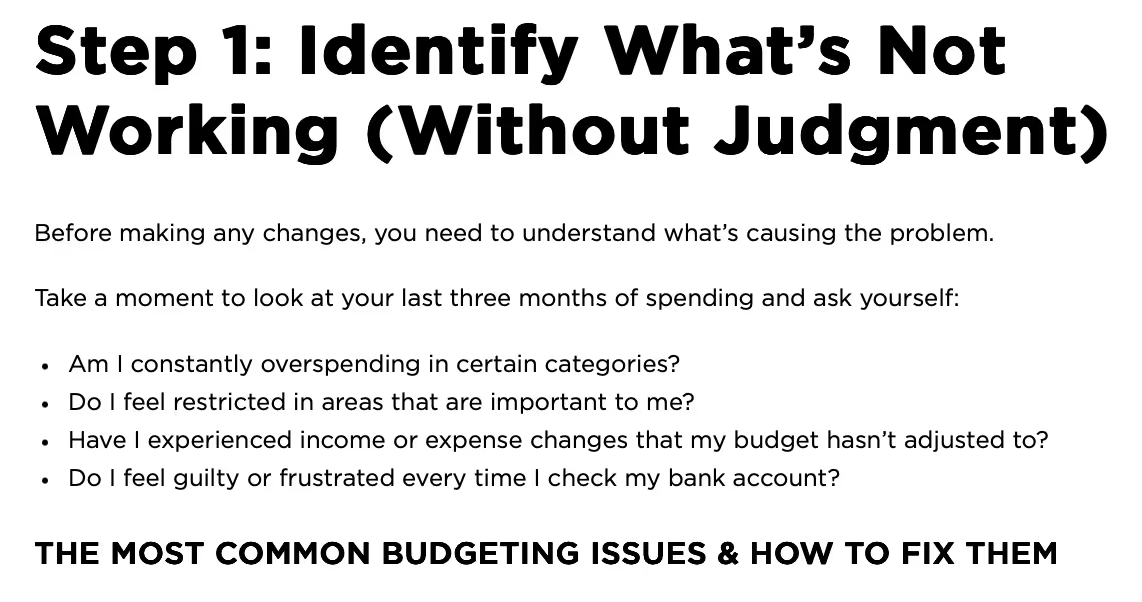
Still, here are a few questions you should ask yourself when trying to pinpoint the right niche:
Does it solve a real problem?
Ideally, your chosen niche should solve a problem people commonly deal with. If you struggled with the same issues and found a solution yourself, that's even better.
Problem-solving content can be a conversion magnet, as you offer your target audience a genuine solution to their issues, something they're willing to pay for or that will earn you their trust.
Again, TheBudgetMom helps single moms improve their financial literacy.
It's safe to say that managing your finances is difficult already, but being a single mother makes it all the more challenging. Kumiko Love helps her target audience overcome these challenges, and she's living proof that it's possible.
Are you passionate about it?
“I'm convinced that about half of what separates the successful entrepreneurs from the non-successful ones is pure perseverance.... Unless you have a lot of passion about this, you're not going to survive. You're going to give it up. So you've got to have an idea, or a problem or a wrong that you want to right that you're passionate about; otherwise, you're not going to have the perseverance to stick it through.”
— Steve Jobs

To put it differently, building up a profitable business is often mentally draining. Having genuine passion will probably give you the fuel necessary to push through in this case—you might get burnt out otherwise.
Plus, passion nudges you to put extra effort into serving better and better products or services, and your target audience will feel that.
You can tell TheBudgetMom genuinely enjoys personal finance and has a lot of experience with it.
Someone who's in a particular niche purely for monetary gain may not have the same dedication. They might prioritize profit over quality.
Do you have existing experience, knowledge, or authority in the niche?
If you do, be sure to bring it up. Take your previous jobs, projects, or any other relevant experiences and use them as social proof to demonstrate your authority and expertise throughout your website's content.
This is super important to win both your audience's and the algorithm's favor. Backing up your statements with personal experiences signals to search engines that your content is unique and genuinely useful.
Meanwhile, you'll show readers that you know what you're talking about and can put yourself in their shoes—it makes you a lot more credible and relatable.
Do you have an existing network to tap into?
Try to find active communities around your target niche.
- This step helps you confirm that your niche has potential and there's a sizeable target market.
- You can also get actively involved in these communities and build a presence to gain quick traction once you roll out your business.
Sticking with TheBudgetMom, she started out by developing a Facebook group where people could share finance tips.
Consider a similar approach—build up email lists, set up or get involved in social media groups, subreddits, Slack communities, and so on, to get people together and spread the word about your projects.
2. Perform niche research
Next, perform niche market research to solidify your business ideas and see if there's genuine demand for your niche.
Check how easy it would be for you to enter and grow in the market. A niche that's too broad will probably be oversaturated with competitors, while a target market that's too narrow will have a limited audience pool.
Sub-niches are a good idea here—secondary segments that target more specific audiences within a particular area.
Sticking with financial education, personal finance for college students is a great sub-niche example.
For instance, College Money Matters offers personal finance tips specifically dedicated to helping students avoid large debts.

That said, let's go through a few quick and easy methods to help narrow down your search.
Use Google
Google search features like Autocomplete suggestions, People Also Ask boxes, and Related Searches are quick ways to find potential niches worth targeting—simply type in your main keyword and see what pops up.
Look for any recurring patterns, as they indicate the topic in question is highly sought after by users. Google search features display these results based on various criteria, like user search volumes and trends.
For example, here's what happens if I type "personal finance for" in the search bar:

Judging by the Autocomplete suggestions, it's safe to say that personal finance for younger generations is a pretty popular sub-niche.
Use niche research tools
Dedicated keyword research tools further narrow down your search and help confirm your conclusions through data-backed insights.
- Pay particular attention to metrics like search volumes and ranking difficulty. They tell you whether your business niche is sought after and if there's room for you in the market.
- Also, analyze search trends to measure your niche's popularity over time. Ideally, you want to spot evergreen niches—market segments that maintain consistent relevance and user interest over time—and not fads.
Selecting the right niche gives you a much higher chance of winning.
Here's a brief rundown of the tools you can use:
Google Trends
- What it does: Tracks the popularity of search terms over time
- Why it’s helpful: Helps identify whether interest in your niche is growing, declining, or seasonal.
AnswerThePublic
- What it does: Visualizes questions and search phrases people type into Google.
- Why it’s helpful: Useful for understanding customer pain points and generating content ideas.
Exploding Topics
- What it does: Highlights trending topics before they become mainstream.
- Why it’s helpful: Helps spot emerging niches early with trend data and forecasts.
Facebook Audience Insights
- What it does: Gives demographic and behavioral data on different audience segments.
- Why it’s helpful: Helps understand your potential audience size and preferences.
SparkToro
- What it does: Shows what your audience reads, listens to, follows, and talks about.
- Why it’s helpful: Useful for discovering niche influencers, media, and content channels.
Surfer
To find your niche with Surfer,
- Head to Topical Map
- Enter a head topic that your niche falls under
- Surfer will then generate a bunch of related subtopics
Evaluate them by keyword difficulty and search volume to estimate the market size and make your decision.
For example, here is a snippet from 53 sub-niches under "cybersecurity."
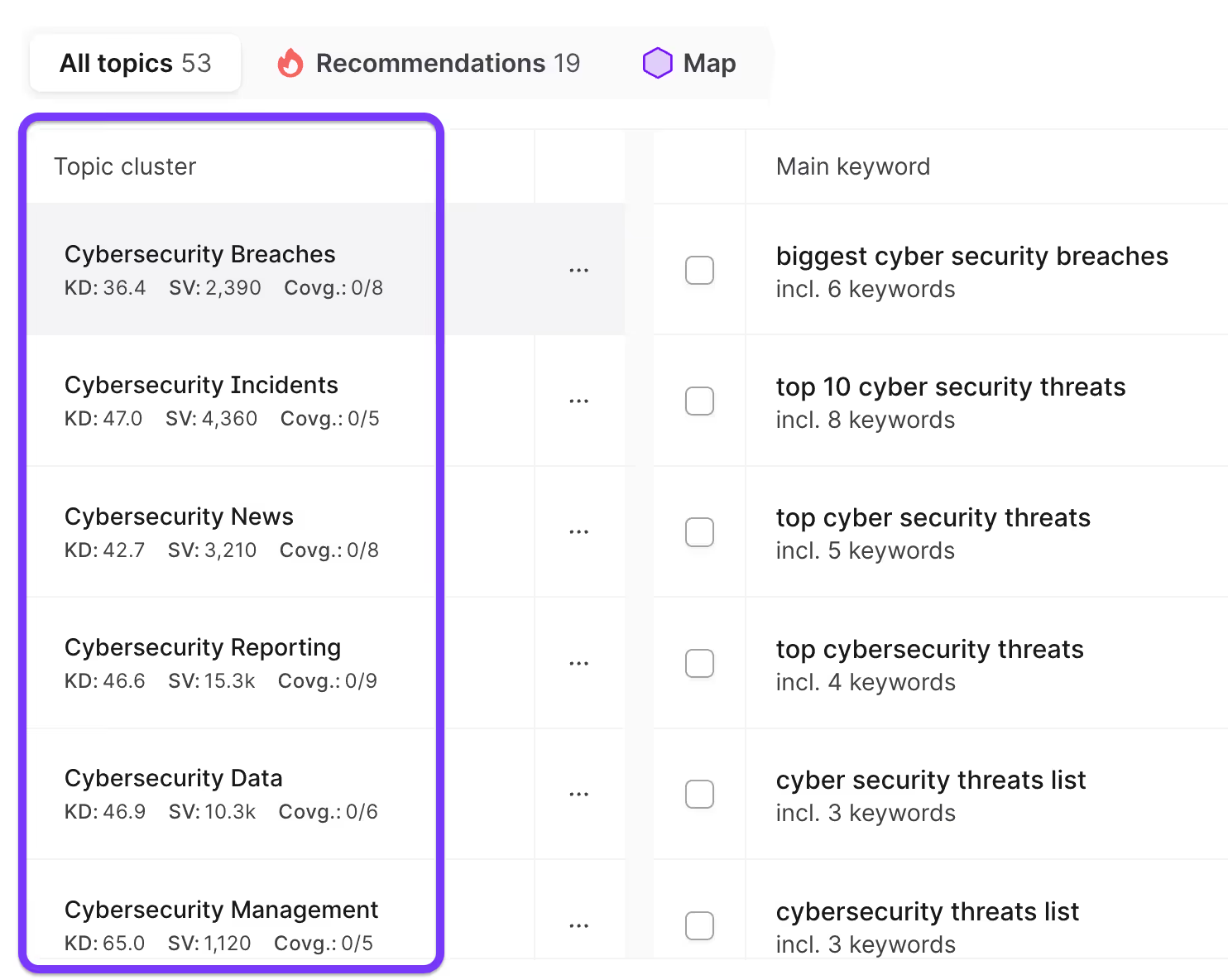
Ahrefs
- What it does: Deep SEO toolset that analyzes keyword opportunities, backlinks, and competitor performance.
- Why it’s helpful: Ideal for serious market research and competitive analysis.
SEMrush
- What it does: Tracks organic search data, paid advertising, traffic analytics, and more.
- Why it’s helpful: Comprehensive suite for keyword research, content strategy, and market trends.
Statista
- What it does: Offers industry reports, statistics, and data charts across various markets.
- Why it’s helpful: Essential for market sizing, financial potential, and trend validation.
Browse forums
Online forums are excellent places to perform market segment research with insights pulled from consumers themselves. People typically use community forums because they want unfiltered first-hand information from their peers, or simply can't find the exact information they're looking for elsewhere.
That means sites like Quora, Reddit, and other niche forums are perfect for pinpointing your target customers' needs, wants, and pain points, along with potential underserved market segments.
For example, r/StudentLoans is made for college students, perfect if I were looking to find relevant topic ideas for this audience segment, just like this one:

Check the top comments and most-commented threads to find discussion points that target audiences engage with the most.
Browse social media like LinkedIn, Instagram, or TikTok
On a similar note, check social networks to spot:
- Trending hashtags
- Social media profiles
- Influencer content for your primary niche
Measure average engagement levels, content tone, and posting formats to see whether target audiences resonate with the topic in question and the formats that attract the most attention.
For example, I typed in "#personalfinance" on Instagram and found that carousels and infographics covering quick money management tips, book recommendations, and inspiring quotes generate a lot more engagement compared to posts that cover other personal finance-related topics, like stock trading, crypto, etc.
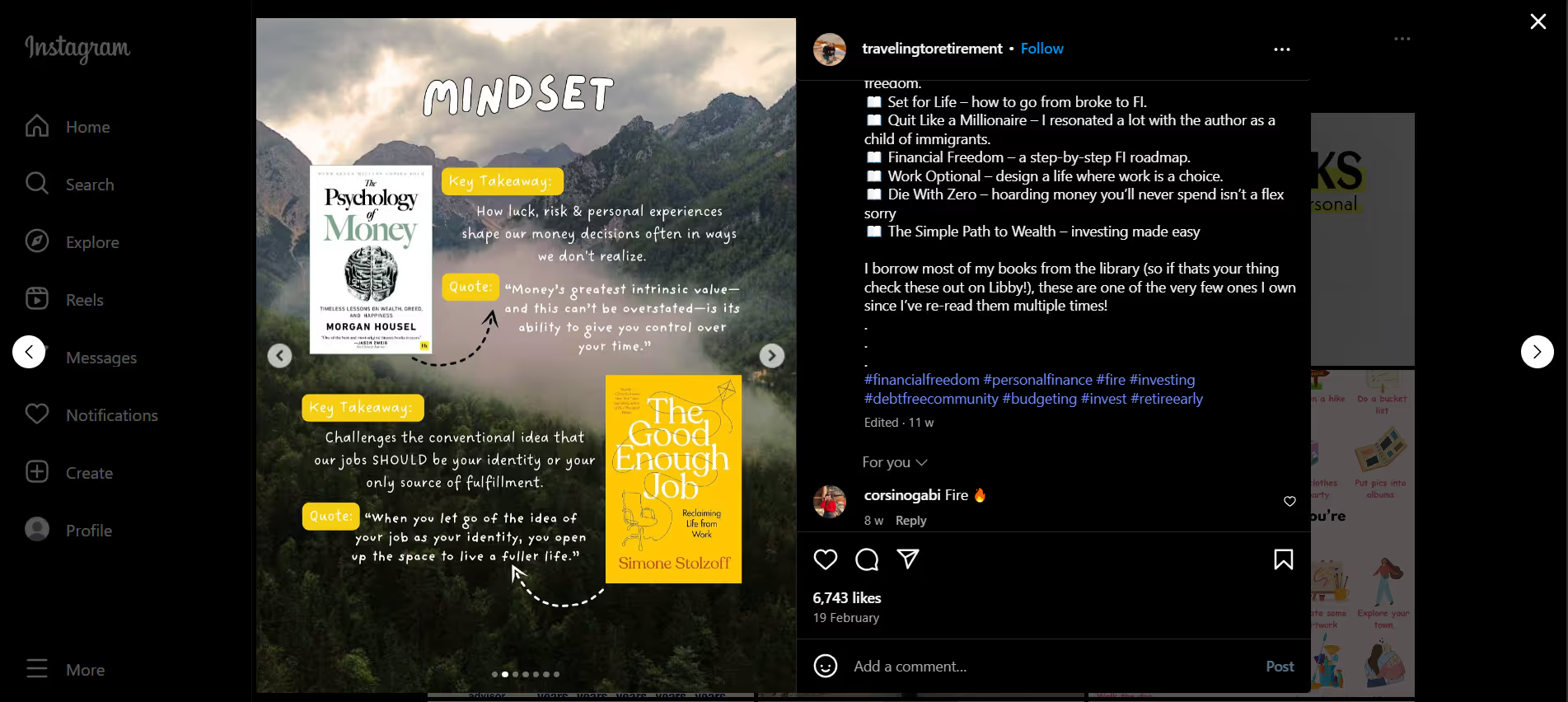
Does the niche require services, products, or digital content?
Use all the insights pulled from the steps above to identify how to meet your target audience's needs and pain points.
What exactly would solve their problems? Physical products, software solutions, services, or educational materials?
For example, sticking with the personal finance category, we could say the educational content—blog posts, e-books, and courses—would work best based on the details we collected above.
3. Check the niche competition
Once you find a few niche ideas, check how saturated the markets are. SERP analyses are an easy way to do so—simply type in keywords closely related to your niche and see what pops up in the search results.
Suppose I'm thinking about setting up a blog around men's fitness. Search terms like "workout plans for men" would give me a quick overview of who I might compete against.

Case in point, the top search results are taken up by massive industry authorities, like Healthline, Men's Health, etc. Finding a sub-niche would be recommended to bypass them, as it would be nearly impossible for me to outrank these websites directly.
While you're at it, check the most popular content types around your particular niche—blog posts, videos, courses, sales pages—to build an idea around your content marketing strategy.
Find out how your competitors are doing
Take a handful of competitors and analyze their strategies to identify their target customers, strengths, and weaknesses. If you're in a similar situation to what I just showed above, try to spot market gaps by looking at their content and how they position themselves to their audiences.
Again, you don't want to be in a niche completely overrun by huge companies. But you don't want to be in a segment so narrow it barely has any competition, either—the audience pool might be too small to generate profits.
Try to find a sweet spot.
In my case, the Fit Father Project is an excellent example.

It's a fitness site strictly targeting men over 40, an underserved audience segment in an otherwise overcrowded niche.
4. Estimate market size and business potential
Use market research tools like GMInsights, Statista, and MarketResearch.com to evaluate your niche market size and see whether it's possible to grow a full-time business out of it.
Look for signs that indicate a profitable niche, like strong product demand and high commercial intent-based keyword search volumes, and pinpoint various monetization options to measure scalability.
Let's see how you can do so.
How big is the market, and does the niche have money?
Check how much money flows into your target niche to estimate market size—look at year-to-year reports and forecasts to determine whether the niche in question will stay profitable or lose relevance over time.
For example, I used GMInsights to get a quick report on the pet tech niche.

The market value sat at $10.5 billion in 2023, and it's predicted to almost quadruple in size by 2032.
Plus, the Compound Annual Growth Rate (CAGR) for 2024 - 2032 sits at 16.5%, which is a good sign. That means your investment will grow on average by 16.5% each year during this specific time frame (assuming you reinvest all profits annually).
Using this data, we can conclude that pet tech is a highly profitable niche with excellent growth potential in the not-too-distant future.
Of course, you can go even more in-depth and look at average order values, high-CPC keywords, and so on to gauge niche profitability more accurately.
What are the existing opportunities in the niche?
Dig deeper into the data and find multiple ways to monetize your niche. Sticking with the example above, I can see that the pet wearable segment makes up a sizeable chunk of the general pet tech market.
That means high-tech pet wearables are in high demand, and there are loads of businesses operating in this sub-segment, like Whistle, for example:
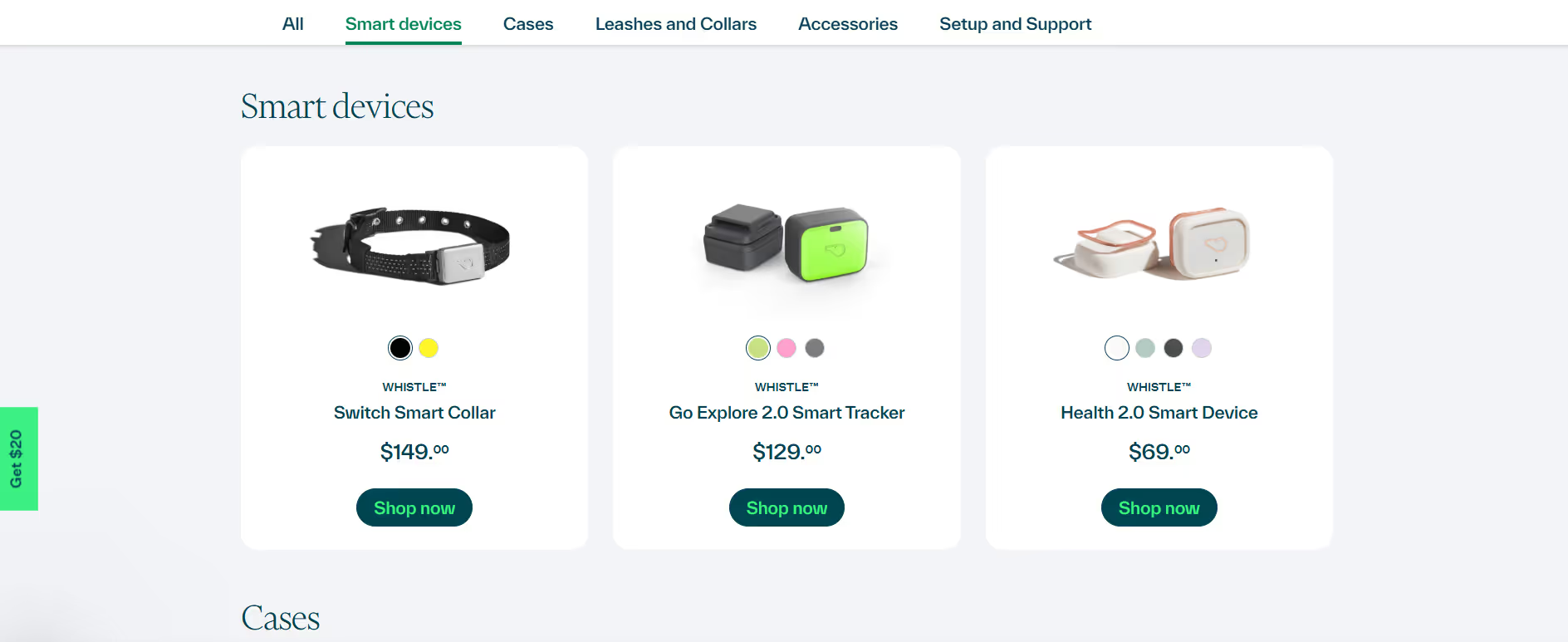
Building a blog around pet-tech products and monetizing it through affiliate marketing might be feasible. It's also worth looking at affiliate platforms like ShareASale and ClickBank to see how many other websites have already adopted this approach and their commission rates.
Is the niche seasonal or occasion-driven?
Use tools like Google Trends to measure fluctuations in search interest within your target niche and determine whether the market is evergreen, seasonal, or occasion-based—also helpful to decide whether your business has full-time commitment potential, or if it's better to treat it as more of a side activity.
For example, the "Timberland Boots" keyword consistently peaks in late November each year.
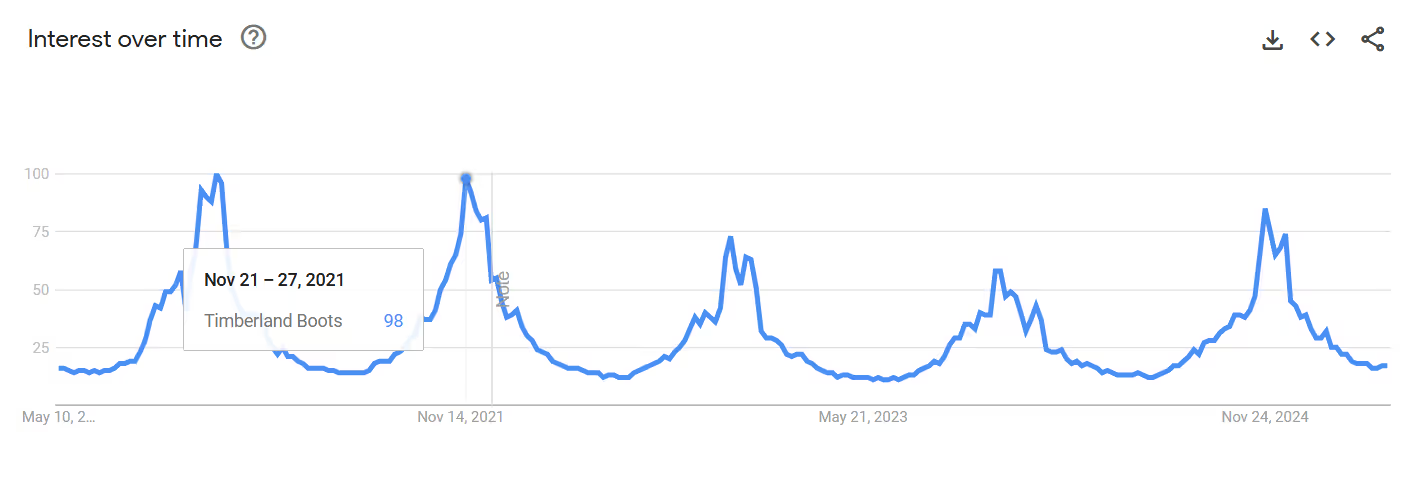
This makes sense since people start gearing up for winter around this time frame.
5. Is the niche growing or declining?
You can also cross-reference Google Trends results with the industry insights I showed earlier to see whether your niche is:
- On the uptick
- Going downwards
- Stays consistent
- How the niche market is likely to evolve.
For example, I typed in "vertical farming" in Google Trends and saw that this search term experienced a surge in search interest over the last decade, and reached an all-time high in the last few years.

Looking up this niche on FortuneBusinessInsights revealed that this industry is likely to boom in the future.

The industry is expected to hit $50.1 billion by 2032, with a CAGR of 28.8%. Although profitable, ask yourself the following question to further narrow down your approach:
What are the consumer trends?
Check industry newsletters, Substacks, and trend reports to pinpoint consumer trends within your target niche and spot sub-segments with high potential.
While browsing Medium, for instance, I stumbled upon a podcast that strictly covers vertical farming.

It's full of interesting topics, like repurposing abandoned buildings into vertical farms, building vertical farms in packed urban areas, and so on.
Is there room for vertical or horizontal expansion?
Horizontal expansion means you can appeal to larger audience pools by offering adjacent products related to your core offering. If you sell hiking gear, you could later expand to camping and survival equipment, for example.
In contrast, vertical expansion means you aim to attract an up-market audience by offering premium or specialized versions of your core products. If you're a fitness coach, you could also offer advanced programs for athletes or corporate wellness packages on top of your regular services.
Here's a real-life scenario:
Warby Parker started as an online direct-to-consumer eyewear brand. They eventually expanded vertically by:
- Designing their own frames (instead of using third-party manufacturers).
- Opening retail stores to control the in-person shopping experience.
- Offering in-house eye exams and prescriptions in select locations.
- Building their own supply chain and distribution network.
Here are a few extra questions to ask yourself and better guide your approach:
Are there adjacent audiences you can serve later?
Check if your target audience has extra needs or interests you can cover by expanding your product offering, or if there's an upmarket segment you could tailor your core products to.
Can you create educational or digital products as extensions?
A cost-effective way to expand horizontally. If educational/digital products are your core products, however, you could add upscale pricing packages or opt for a freemium pricing model.
Is there potential for brand partnerships or affiliate offers?
Brand partnerships through white-labeling can be efficient in expanding your product offering while minimizing costs. You could use affiliate marketing to push these products to a new audience segment.
6. Can you stand out in the niche?
Look at your business idea from an objective perspective and figure out whether you can bring something unique to the table.
HumbleDollar is an excellent example—a site covering financial education and commentary. Here's why:

- Why it stands out: In a crowded space dominated by flashy influencers and aggressive marketing, HumbleDollar offers simple, honest, and jargon-free financial advice. Founded by Jonathan Clements, a former Wall Street Journalcolumnist, it prioritizes clarity, ethics, and long-term thinking.
- How it's different: It avoids hype and pushing affiliate products and focuses on thoughtful essays and community contributions. Its minimalist design, reader-focused tone, and transparent editorial standards have earned it loyal followers despite operating in one of the internet’s most saturated niches.
Is there something unique you can do?
Look at your previous projects and see whether you can pull something from them—maybe you took an unconventional approach or followed frameworks and delivered formats others don't cover.
Also, check if you can represent an otherwise marginalized audience segment. The Financial Diet, for example, is a finance website that strictly appeals to women.

Just like The Budget Mom, they give women a dedicated space to discuss and learn about personal finance in an otherwise male-predominant niche.
Can you provide a better product for cheaper?
See if you can find ways to provide better value for money than your competition, either through a cheaper product that maintains the same quality standards as your competitors or by offering better quality products at the same price tag as your competition.
Of course, there are other ways you can improve your product's perceived value, like providing excellent customer service, for instance. Examine user reviews, in-depth product comparisons, and so on, to find common competitor flaws you can capitalize on.
7. Is the niche financially sustainable?
Outline your long-term and short-term costs and revenue potential to see whether your niche is profitable.
First, evaluate initial startup and marketing costs and set clear monetization timelines. Here are a few questions to help better guide your approach:
Does it require paid advertising?
If yes, estimate your customer acquisition costs (CAC) to see whether paid ads are worth it.
You can do this by adding up your total estimated sales and marketing spend and dividing them by the number of customers you expect to draw into your business in a given time frame.
Calculate both organic (SEO-focused) and inorganic CAC (paid advertising-oriented) to see which customer acquisition channel is most cost-effective.
Cross-reference your results against industry averages to see whether your estimates are realistic.
Is the initial investment high?
Consider all marketing and product-related expenses to gauge your initial investment. This includes writers, editors, designers, website setup and maintenance, and all software needed for business-related activities.
Don't forget about inventory costs if your business niche requires it.
Also, look at the job market to see whether you can cut costs by working with part-time freelancers, and where you should invest in full-time employees—think freelance content writers and designers, but in-house content managers, for example.
Is the cost of customer acquisition very high?
Study the average CAC in your niche market and model thresholds based on your research. Take keywords popular in your business niche and identify their PPC costs to better narrow down your CAC.
For example, the CAC for legal services like personal injury law costs $1,000 to $2,000 per client, while keywords like "car accident lawyer" cost $80 to $108 for each single click.
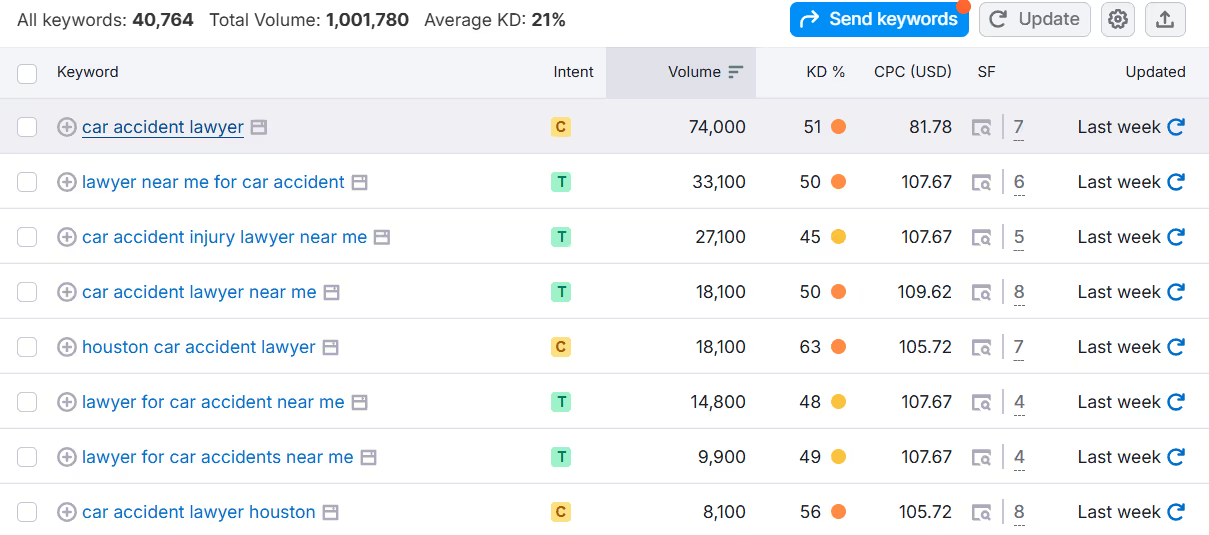
Undoubtedly, the CAC here is huge. Prioritizing customer loyalty and retention over acquisition is recommended—think re-targeting campaigns, trust-building, follow-ups to previous customers, and so on.
Retaining existing customers is often cheaper than acquiring new ones.
8. Avoid overly ambitious projects
Focus on simplicity and speed to launch. If you're a fan of Shark Tank, you'll notice that the simplest products are often the most profitable—Scrub Daddy, Tipsy Elves, Bombas, and so on.
That's because these businesses sell products that appeal to large pools of target customers, but solve hyper-specific pain points, require minimal manufacturing and marketing spend, and facilitate large profit margins.
The more complicated your project is, the longer it will take to roll it out, and the more difficult it will be to market it.
In other words, avoid the following:
Don’t attempt to create a new category
Pulling Amazon or Netflix-like moves and completely re-inventing industries requires massive capital and huge marketing budgets. You'll have no existing audience pool to target, so you'll have to educate and create one on your own. Even with huge capital, you might not pull through—think Metaverse.
Stick to simple, yet innovative approaches to existing markets. For example, Tipsy Elves is a clothing company with a twist. Rather than seasonally-based products, the company's fashion collection is specifically based on holiday and occasion-themed clothing.
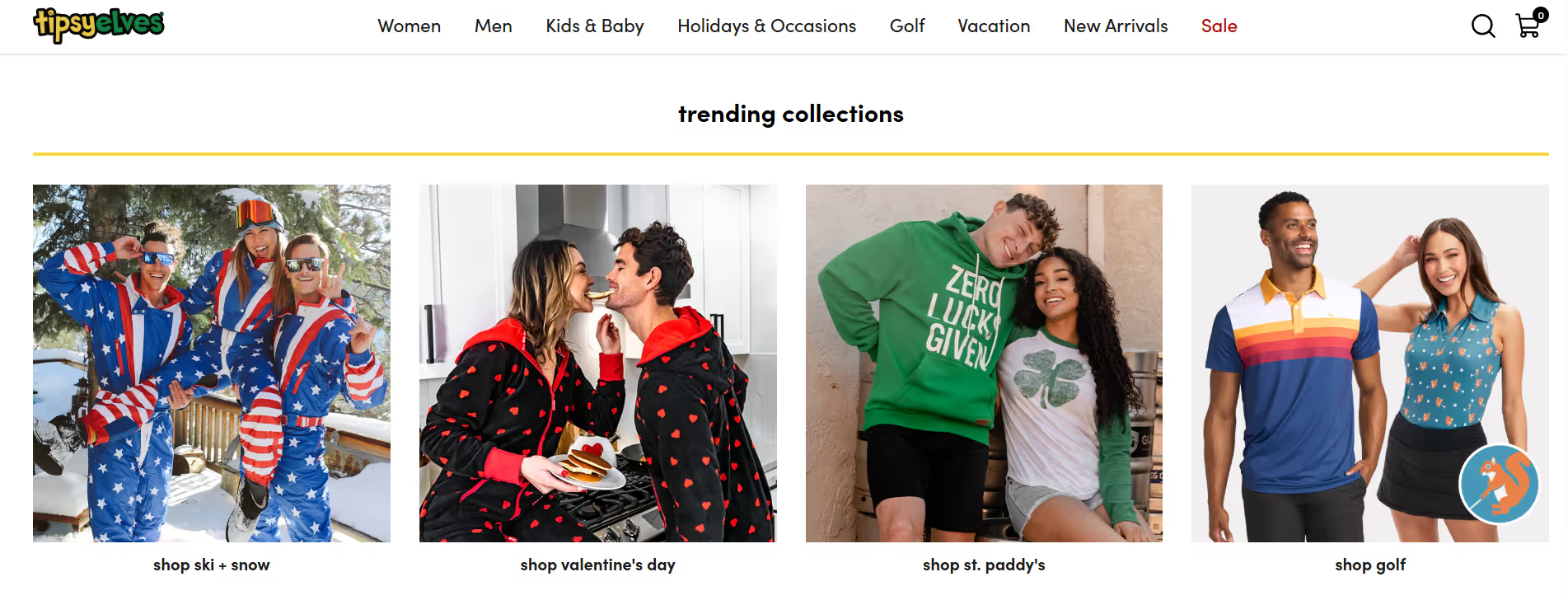
This niche market brought the company huge success after airing on Shark Tank, reaching a net worth of over $6 million.
Don’t attempt to change existing behaviors
Google Glass and Apple Vision Pro struggled to gain traction partly because these products tried to change consumer behavior—they aimed to persuade consumers to use their smart glasses instead of regular smartphones.
In reality, both device types perform roughly the same tasks, but smartphones are much cheaper. Consumers had little to no reason to switch, outside of trying out novel tech.
To put it differently, try to tack on to and improve existing consumer habits, rather than trying to create new ones. Blueland is another Shark Tank hit.
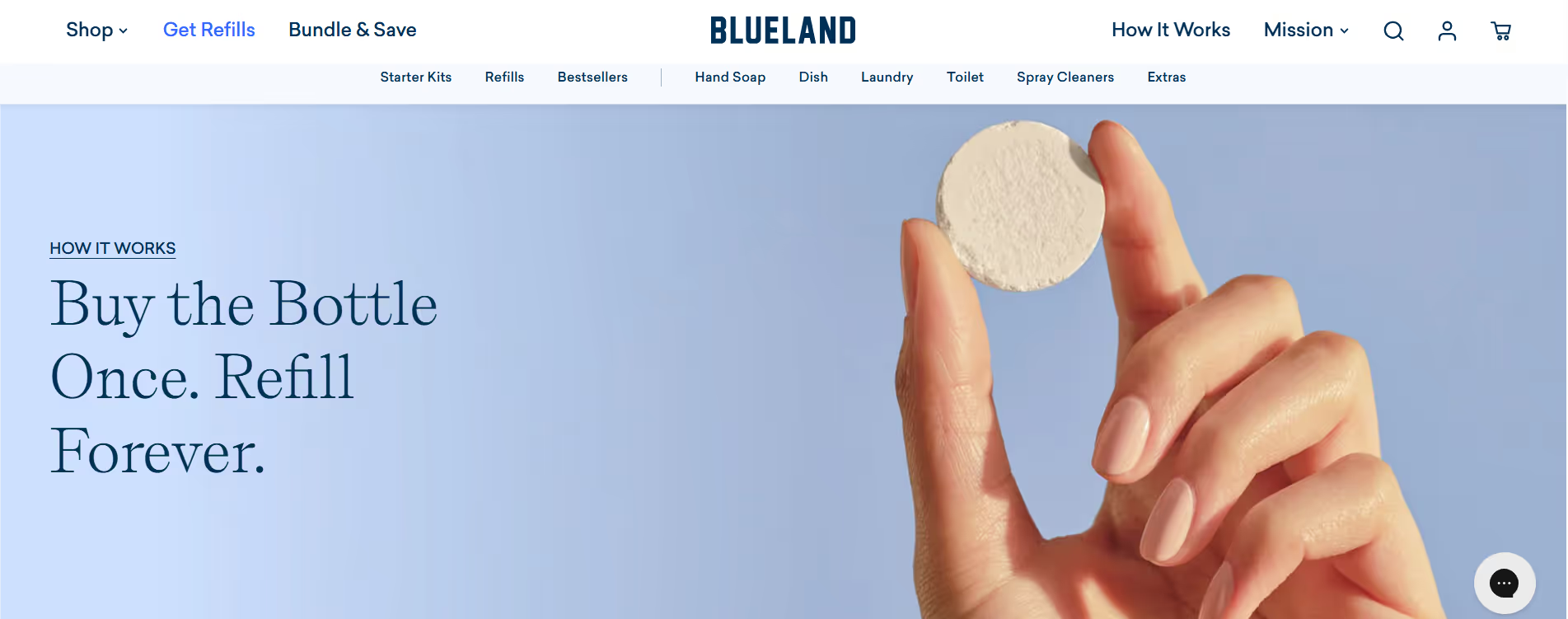
The company's refillable containers and plastic-free home cleaning tablets help environmentally-conscious consumers take a much more eco-friendly approach to house cleaning. The online business reached over $10 million in annual sales as of 2023.
Don’t complicate simple things
Avoid niches that are complicated and hard to explain to avoid market positioning issues and minimize marketing costs.
Simple, yet impactful messaging is often enough to make yourself stand out, regardless of how common your products may be.
Bombas, one of the most successful businesses ever featured on Shark Tank, is an apparel brand that stands out through its unique selling point—the company donates a product to charity for each purchase made.
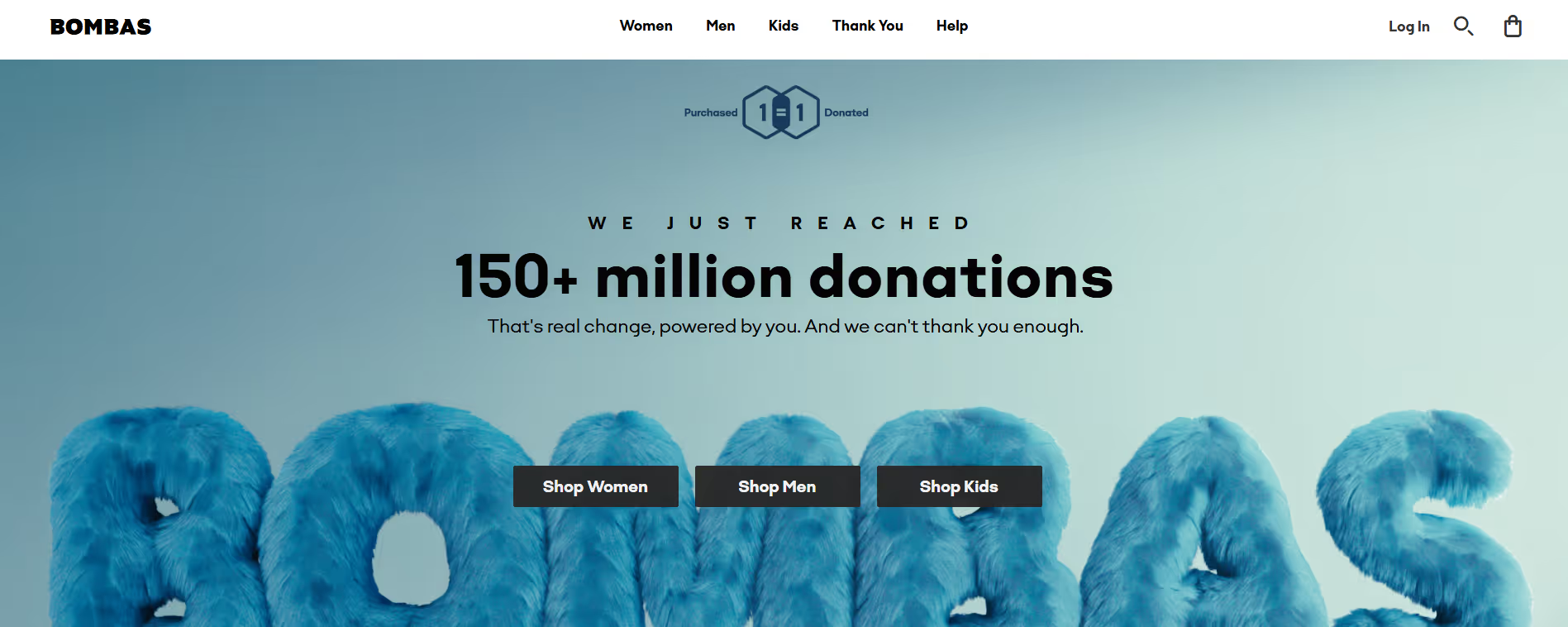
The company is now worth around $3.42 billion and has made over 150 million donations.
Avoid niches that require regulation and licenses
Lastly, be mindful when entering regulated niches that require licenses, certifications, and extensive experience to operate in—health, finance, law, and other Your Money Your Life (YMYL) topics.
That's because Google's E-E-A-T guidelines will play a much more significant role here than in other niche markets.
Unless you have the experience and certifications necessary to prove you're qualified to talk about these topics, you'll have trouble reaching high rankings.
If you do, however, make sure to highlight your expertise through detailed author bios, transparent editorial guidelines, and other trust signals.
For example, each Bankrate post is written by staff with proven experience in the financial industry.
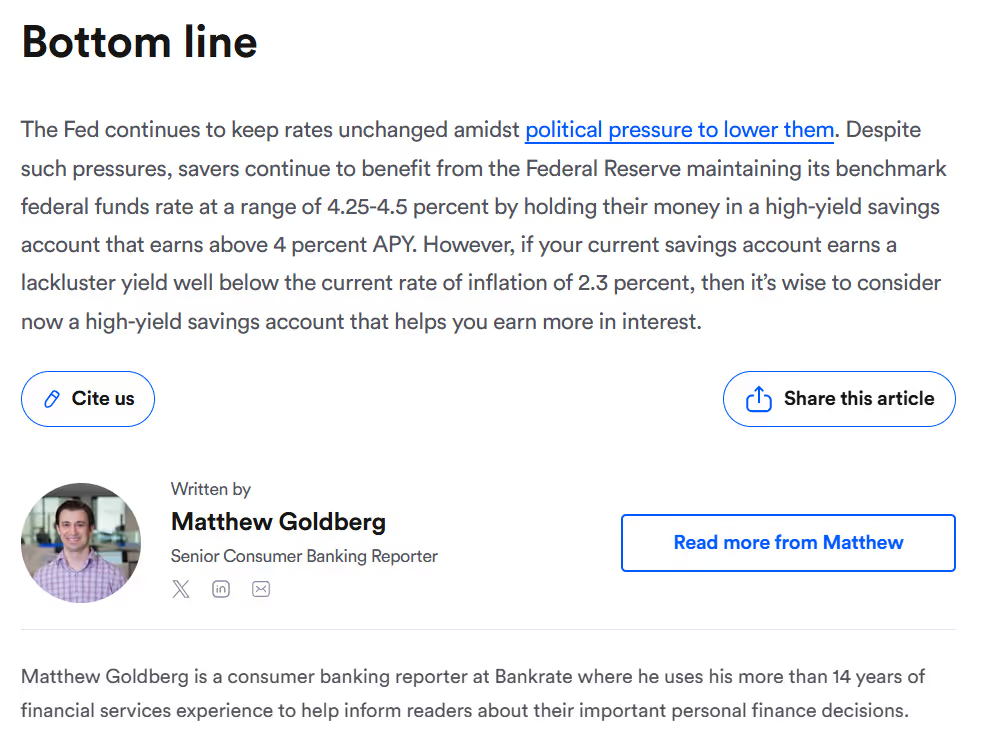
This tells readers and search engines that the authors are genuinely qualified to talk about the topics in question.
9. Start in a narrow niche
Lastly, your niche business should start out small—focus on a sub-segment of your niche market and target well-defined audiences with particular needs and interests. Again, sub-niches face less competition and are easier to manage.
It's best to double down on them until you start gaining traction and establish yourself as an authority. You can then gradually expand horizontally as you build a loyal customer base, boost credibility, and develop your resources.
Case in point, Notion started out as a simple wiki and note-taking tool for solo users. The platform then gradually expanded into a full productivity suite, complete with team collaboration, project management, AI writing tools, as well as solutions dedicated to enterprise-level companies.
5 examples of niches
If you're looking for extra inspiration, let's go through five niche market examples.
Vegan Baking
This vegan sub-niche focuses on plant-based baking recipes. Alongside vegans, this market segment can also target consumers who cannot eat fried food due to dietary restrictions, for example.
This niche business idea is promising because it has good scalability potential—you can expand to product reviews, recipe development, and instructional content to help your target audience live healthier lives.
Case in point, MinimalistBaker is a niche site that covers vegan recipes and has expanded to include a shop section on its website.
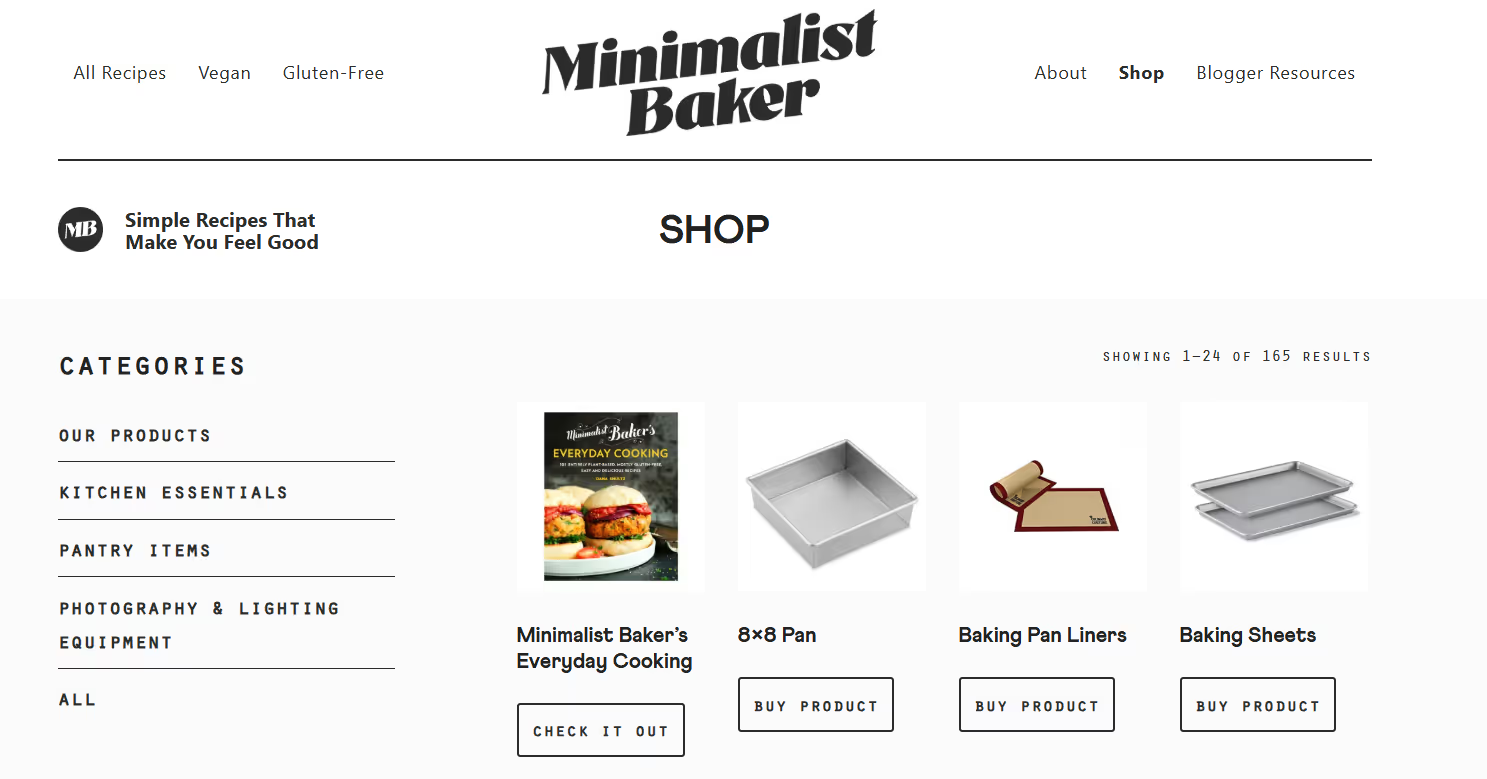
Remote Work Productivity
This one helps remote employees and freelancers work more efficiently by offering tools, tips, and strategies around work-from-home setups. This niche includes loads of topic clusters you can cover—from productivity tool round-ups to time-management tips, and workspace organization best practices or products.
You can also develop job boards for remote positions, just like Remote Work Hub.

Sustainable Fashion
The sustainable fashion industry sub-market targets environmentally conscious consumers through ethical and eco-friendly clothing choices.
You could cover topics like sustainable fashion tips, brands, and materials. Style & Sustain covers all sorts of sustainability fashion-related tips and traditional clothing materials from across the world. It also includes a podcast interviewing industry pioneers.

DIY Home Improvement
The DIY home improvement niche targets customers interested in self-made renovation and decoration projects.
Once again, you have a solid selection of topic clusters to build off this niche market—DIY tutorials, product reviews, and design inspiration showcases—just like Young House Love:

Pet Nutrition and Health
This is a niche profitable for targeting pet owners who want to take proper care of their companions through health tips, dietary advice, and pet care product recommendations, like pet supplements.
PetMD is one such example, a pet healthcare blog covering content written and reviewed by qualified vets.

Key takeaways
- A niche is a specialized market segment that targets a specific group of potential customers within a broader market.
- Finding your niche helps better position your products or services to your target customers, which boosts brand authority, improves marketing ROI, and minimizes competition.
- Pick a personal niche based on your existing passions, knowledge, and expertise. You can also take your favorite hobby into account. This helps offer the audience genuine, unique insights, also useful for better rankings.
- Use Google, dedicated research tools, and online forums to research competition, determine whether there's a genuine interest within your niche, and identify problems you can fix.
- Look up industry reports and market analysis sites, and analyze trends to see whether your niche has potential, if it's sustainable in the long run, and how you can scale in the future.
- Evaluate initial investment, customer acquisition, and advertising costs to see whether your niche has profit potential.
- Start out in a small business niche and focus on simple solutions to maximize profits—you can further expand into broader areas once you gain traction.


.avif)

